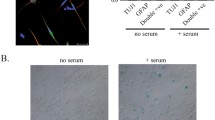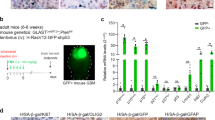Abstract
p16INK4A is a G1-specific cell cycle inhibitor which maps to human chromosome 9p21, a region frequently mutated or deleted in cancer cell lines and primary tumors. In glioblastomas the frequency of homozygous deletions is 40 – 70% making it one of the most common mutations in this tumor type. We have analysed the significance of the loss of this gene in gliomas by introducing the cDNA for p16INK4A into the human glioma cell line U-1242 MG which has a deleted CDKN2 locus. We used the tetracycline repressable vector system and obtained two stably transfected clones that expressed p16INK4A upon induction. p16INK4A expression caused a G1 arrest and enlargement of the cells similar to that of senescent cells. When staining for Senescence-Associated β-galactosidase activity, described to be specific for senescent cells, we could show that the enlarged cells specifically gave a positive staining reaction. This senescence phenotype was dependent on the continuous expression of p16INK4A since it was reversed upon reintroduction of tetracycline suppression. Thus, the induced expression of p16INK4A in these glioma cells reverted their immortal phenotype and caused an immediate cellular senescence.
Similar content being viewed by others
Author information
Authors and Affiliations
Rights and permissions
About this article
Cite this article
Uhrbom, L., Nistér, M. & Westermark, B. Induction of senescence in human malignant glioma cells by p16INK4A. Oncogene 15, 505–514 (1997). https://doi.org/10.1038/sj.onc.1201227
Received:
Revised:
Accepted:
Issue Date:
DOI: https://doi.org/10.1038/sj.onc.1201227
- Springer Nature Limited
Keywords
This article is cited by
-
Expression of cell cycle and apoptosis regulators in thymus and thymic epithelial tumors
Clinical and Experimental Medicine (2016)
-
The protein kinase C-η isoform induces proliferation in glioblastoma cell lines through an ERK/Elk-1 pathway
Oncogene (2007)
-
8-Hydroxydeoxyguanosine induces senescence-like changes in KG-1, human acute myelocytic leukemia cell line
Biotechnology and Bioprocess Engineering (2007)
-
Cellular senescence and chromatin structure
Chromosoma (2007)




